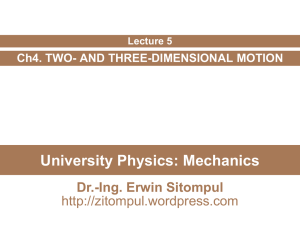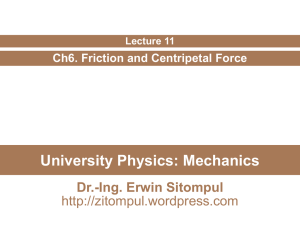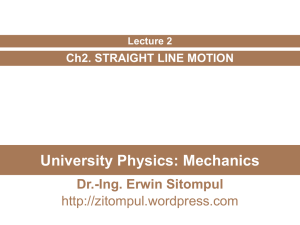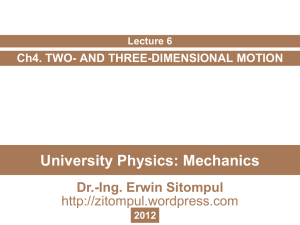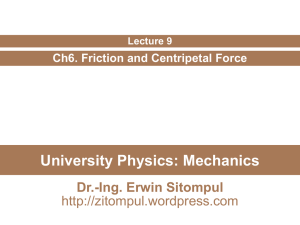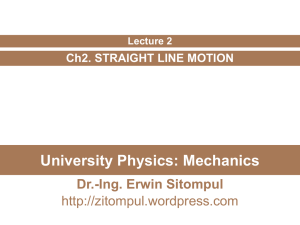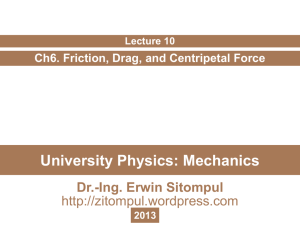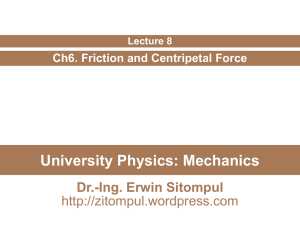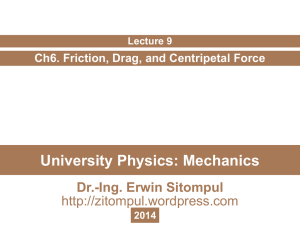University Physics - Erwin Sitompul
advertisement
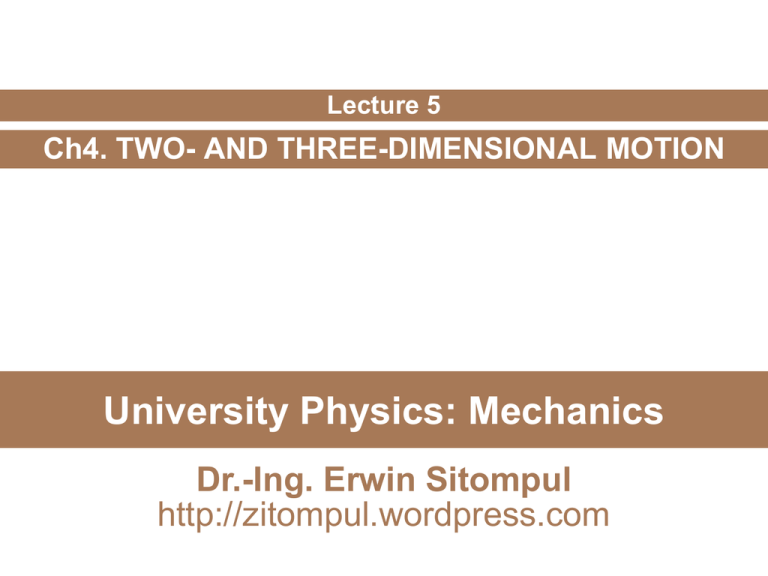
Lecture 5 Ch4. TWO- AND THREE-DIMENSIONAL MOTION University Physics: Mechanics Dr.-Ing. Erwin Sitompul http://zitompul.wordpress.com Homework 4: The Plane A plane flies 483 km west from city A to city B in 45 min and then 966 km south from city B to city C in 1.5 h. From the total trip of the plane, determine: (a) the magnitude of its displacement (b) the direction of its displacement (c) the magnitude of its average velocity (d) the direction of its average velocity (e) its average speed Erwin Sitompul University Physics: Mechanics 5/2 Solution of Homework 4: The Plane → Δr1 B 966 km, 1.5 h 483 km, 45 min Δr→2 A r1 483iˆ km r2 966jˆ km rtotal ttotal t1 45 min 0.75 h t2 1.5 h r1 r2 483iˆ 966jˆ km t1 t2 0.75 1.5 2.25 h (a) the magnitude of its displacement rtotal (483) 2 (966) 2 1080.021 km 243.435 B A (b) the direction of its displacement C 966 rtotal tan 1 483 63.435 • Quadrant I C 243.435 • Quadrant III Erwin Sitompul University Physics: Mechanics 5/3 Solution of Homework 4: The Plane (c) the magnitude of its average velocity vavg rtotal 483iˆ 966jˆ km 214.667iˆ 429.333jˆ km h ttotal 2.25 h vavg (214.667) 2 (429.333) 2 480 km h (d) the direction of its average velocity 429.333 243.435 • Quadrant III vavg tan 1 214.667 (e) its average speed savg total distance traveled Erwin Sitompul total time 483 km 966 km 644 km h 2.25 h University Physics: Mechanics 5/4 Average and Instantaneous Acceleration → → When a particle’s velocity changes from v1 to v2 in a time → interval Δt, its average acceleration aavg during Δt is: average change in velocity acceleration time interval aavg v2 v1 v t t If we shrink Δt to zero, then→→ aavg approaches the instantaneous acceleration a ; that is: d dv dvx ˆ dv y ˆ dvz ˆ ˆ ˆ ˆ (vx i v y j vz k) a i j k dt dt dt dt dt Erwin Sitompul University Physics: Mechanics 5/5 Average and Instantaneous Acceleration We can rewrite the last equation as a ax ˆi ay ˆj az kˆ → where the scalar components of a are: dv y dvx dvz ax , ay , az dt dt dt Acceleration of a particle does not have to point along the path of the particle Erwin Sitompul University Physics: Mechanics 5/6 Average and Instantaneous Acceleration → A particle with velocity→v0 = –2i^ + 4j^ m/s at t = 0 undergoes a constant acceleration a of magnitude a = 3 m/s2 at an angle 130° from the positive direction of the x axis. What is the → particle’s velocity v at t = 5 s? Solution: vx v0 x axt v0 x 2 m s ax 3 cos130 1.928 m s2 vy v0 y ayt v0 y 4 m s ay 3 sin130 2.298 m s2 At t = 5 s, vx 2 (1.928)(5) 11.64 m s vy 4 (2.298)(5) 15.49 m s Thus, the particle’s velocity at t = 5 s is v 11.64iˆ 15.49jˆ m s. Erwin Sitompul University Physics: Mechanics 5/7 Projectile Motion Projectile motion: a motion in a vertical plane, where the → acceleration is always the free-fall acceleration g, which is downward. Many sports involve the projectile motion of a ball. Besides sports, many acts also involve the projectile motion. Erwin Sitompul University Physics: Mechanics 5/8 Projectile Motion Projectile motion consists of horizontal motion and vertical motion, which are independent to each other. The horizontal motion has no acceleration (it has a constant velocity). The vertical motion is a free fall motion with constant acceleration due to gravitational force. ax 0 g 9.81m s 2 ay g Erwin Sitompul University Physics: Mechanics 5/9 Projectile Motion ax 0 v0 v0 x ˆi v0 y ˆj v0 x v0 cos0 v0 y v0 sin 0 Erwin Sitompul ay g University Physics: Mechanics 5/10 Projectile Motion Two Golf Balls v0 x 0 v0 x 0 • The vertical motions are quasiidentical. • The horizontal motions are different. Erwin Sitompul University Physics: Mechanics 5/11 Projectile Motion Analyzed The Horizontal Motion x x0 v0xt x x0 (v0 cos0 )t The Vertical Motion y y0 v0 yt 12 gt 2 y y0 (v0 sin 0 )t 12 gt 2 vy v0 sin 0 gt vy2 (v0 sin 0 )2 2g ( y y0 ) Erwin Sitompul University Physics: Mechanics 5/12 Projectile Motion Analyzed The Horizontal Range x x0 R R (v0 cos0 )t y y0 0 0 (v0 sin 0 )t 12 gt 2 vx = v0x vy = –v0y Eliminating t, v02 R 2 sin 0 cos 0 g • This equation is valid if the landing height is identical with the launch height. Erwin Sitompul University Physics: Mechanics 5/13 Projectile Motion Analyzed Further examining the equation, v02 R 2 sin 0 cos 0 g Using the identity sin 20 2sin 0 cos0 , we obtain v02 R sin 20 g R is maximum when sin2θ0 = 1 or θ0 =45°. Erwin Sitompul • If the launch height and the landing height are the same, then the maximum horizontal range is achieved if the launch angle is 45°. University Physics: Mechanics 5/14 Projectile Motion Analyzed • The launch height and the landing height differ. • The launch angle 45° does not yield the maximum horizontal distance. Erwin Sitompul University Physics: Mechanics 5/15 Projectile Motion Analyzed The Effects of the Air Path I: Projectile movement if the air resistance is taken into account Path II: Projectile movement if the air resistance is neglected (as in a vacuum) Our calculation along this chapter is based on this assumption Erwin Sitompul University Physics: Mechanics 5/16 Example: Baseball Pitcher A pitcher throws a baseball at speed 40 km/h and at angle θ = 30°. h 30 (a) Determine the maximum height h of the baseball above the ground. vy v0 y gt 0 5.56 9.8t 5.56 0.567 s t 9.8 h y y0 v0 yt 12 gt 2 1 (5.56)(0.567) 2 (9.8)(0.567)2 1.58 m Erwin Sitompul 40km h 11.11 m s v0 y v0 sin (11.11)sin 30 5.56 m s v0 x v0 cos (11.11) cos 30 9.62 m s x x0 v0 xt y y0 v0 y t 12 gt 2 v y v0 y gt v y2 v02y 2 g ( y y0 ) University Physics: Mechanics 5/17 Example: Baseball Pitcher A pitcher throws a baseball at speed 40 km/h and at angle θ = 30°. 30 d (b) Determine the duration when the baseball is on the air. ton air tup tdown 0.567 0.567 1.134 s (c) Determine the horizontal distance d it travels. d x x0 v0xt (9.62)(1.134) 10.91 m Erwin Sitompul x x0 v0 xt y y0 v0 y t 12 gt 2 v y v0 y gt v y2 v02y 2 g ( y y0 ) University Physics: Mechanics 5/18 Example: Rescue Plane A rescue plane flies at 198 km/h and constant height h = 500 m toward a point directly over a victim, where a rescue capsule is to land. (a) What should be the angle Φ of the pilot’s line of sight to the victim when the capsule release is made? Released horizontally y y0 v0 yt 12 gt 2 (500) (0) (0)t 12 (9.8)t 2 2 500 2 t 102.041 9.8 t 10.102 s x x0 v0xt (55)(10.102) 555.61 m Erwin Sitompul h y y0 d x x0 d tan h 1 555.61 tan 500 48.016 1 University Physics: Mechanics 5/19 Example: Rescue Plane A rescue plane flies at 198 km/h and constant height h = 500 m toward a point directly over a victim, where a rescue capsule is to land. (b) As the capsule reaches the → water, what is its velocity v in unit-vector notation and in magnitude-angle notation? vy v0 y gt vy (0) (9.8)(10.102) 99 m s vx v0 x 55 m s Erwin Sitompul Released horizontally h y y0 d x x0 v 55iˆ 99jˆ m s Unit-vector notation v 113.252 m s 60.945 Magnitude-angle notation University Physics: Mechanics 5/20 Example: Clever Stuntman A stuntman plans a spectacular jump from a higher building to a lower one, as can be observed in the next figure. Can he make the jump and safely reach the lower building? y y0 v0 yt 12 gt 2 (4.8) (0) (0)t 12 (9.8)t 2 2 4.8 2 t 0.98 9.8 t 0.99 s He cannot make the jump x x0 v0xt (4.5)(0.99) 4.46 m x x0 v0 xt y y0 v0 y t 12 gt 2 v y v0 y gt v y2 v02y 2 g ( y y0 ) Time for the stuntman to fall 4.8 m Horizontal distance jumped by the stuntman in 0.99 s Erwin Sitompul University Physics: Mechanics 5/21
